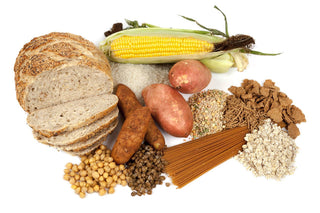Are you getting the recommended 25-38 grams of fiber daily? Although you're trying to heed the advice to increase your fiber intake, most likely you're falling considerably short of the recommended daily target. Reaching this daily target is key especially if you're trying to lose weight.
Emerging research which has examined the role that certain types of fiber play in weight management may provide impetus for you to increase your fiber intake. The World Health Organization has identified fiber as the only dietary ingredient with “convincing evidence” showing a protective effect against weight gain and obesity. That’s because fiber-rich foods take longer to digest and result in an increased feeling of fullness and satiety.
Fiber comes from plant sources (nuts, whole grains, legumes, fruits and vegetables) and is typically classified as either soluble or insoluble. Although most plants have a combination of both types, foods are often classified based on their predominance of soluble or insoluble fiber. Some foods, like flax seed, have a more natural balance of insoluble to soluble fiber.
Soluble Fiber
Soluble fiber is not digested but when mixed with water, forms a gel-like substance and swells. This type of fiber - sometimes referred to as “prebiotic” fiber - can be fermented by the bacteria in the large intestine. Food sources of soluble fiber include oat/oat bran, dried beans and peas, nuts, barley, fruits (such as oranges and apples), vegetables (such as carrots) and psyllium seed husk. Inulin and fructo-oligosaccharides (FOS) are two types of soluble fiber that are sometimes combined with probiotics to enhance the development of beneficial bacteria within the gastrointestinal tract.
Soluble fiber plays a role in intestinal health and may be helpful for relieving diarrhea, constipation and abdominal discomfort. Soluble fiber is also noted for its benefit in lowering total cholesterol and LDL or “bad” cholesterol, providing cardiovascular benefit. Soluble fiber moderates blood glucose levels, which is beneficial for people with diabetes.
Insoluble Fiber
Insoluble fiber, which does not dissolve in water, passes through our intestines largely intact. Sources of insoluble fiber include whole grain foods, wheat and corn bran, nuts and seeds, vegetables and the skins of some fruits. Insoluble fiber moves bulk through the intestines and is responsible for keeping us “regular”. Insoluble fiber is associated with intestinal health including a reduction in the risk and occurrence of colorectal cancer, hemorrhoids and constipation.
Resistant Starch
Research has identified yet a third type of fiber called resistant starch. As the name implies, resistant starch (a carbohydrate) “resists” digestion in the small intestine. Instead, this starch passes through to the large intestine where, through fermentation, the starch acts like dietary fiber.
Resistant starch and dietary fiber do not provide any short-term energy (also known as calories) but have a variety of physiological effects in the large intestine. Because this type of starch is not digested it is referred to as a non-glycemic carbohydrate (does not affect blood sugar levels).
Resistant starch is naturally present in foods such as whole grains and legumes. For example, a half cup of cooked navy beans provides 9.8 grams of resistant starch. Of the four classes of resistant starches (RS1, RS2, RS3, RS4), RS2 is insoluble, is fermented in the large intestine and is a prebiotic fiber. RS2 provides some of the health benefits of both soluble and insoluble fiber, in addition to some other unique benefits.
Currently, there is only one commercially-available natural resistant starch from corn on the market called Hi-maize®. This food ingredient starts with a high amylose corn hybrid (high amylose corn typically contains 50 to 70 percent amylose starch compared with 30 percent for normal corn) produced through plant breeding. This natural fiber made from corn can be added to breads, cereals, pasta, nutrition bars and more.
Over 200 published, peer-reviewed studies have examined the role that high amylase corn plays in intestinal health, glycemic management and energy. For example, one study demonstrated that eating food with made with resistant starch from high amylose corn had more of an impact on satiety than other types of fibers (corn bran, barley, beta-glucan). Another study conducted in 2008 found that dietary consumption of Hi-maize resistant starch resulted in 10% fewer calories being consumed in the following 24 hours.
Commercially, resistant starches have been successfully used in breads, cakes, pasta, cereals, snacks and other baked goods. However, you probably won’t easily find where the ingredient is listed on the label. Different types of resistant starch must be labeled in different ways as food ingredients. Some are listed as dietary fiber (RS2) and designated simply as “resistant cornstarch” or “corn starch”. Other types of resistant starches can be labeled as “maltodextrin” (RS3) or as “modified food starch” (RS4).
If you want to experiment using this ingredient in your own baking, King Arthur Flour offers a Hi-Maize Natural Fiber that can be substituted for up to ¼ to 1/3 the flour used in your baked goods. The fiber can be added to soups, sauces, and smoothies.
As our knowledge builds in the fiber category, old designations of “soluble” vs “insoluble” fiber will probably change. Newer, more accurate designations which better describe the physiological effects of fiber might include “dietary fiber” (fiber naturally present in foods), “functional fiber” (fiber with proven health benefits which are added to foods) and “total dietary fiber” (the sum of dietary fiber and functional fiber).
As consumers become more aware, they will recognize that all fibers are not created equal. Food manufacturers will play a role in helping consumers identify the differences between different types of fiber and their varied benefits including bulking, cholesterol lowering and metabolism.

